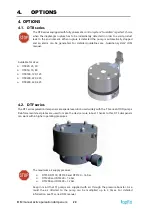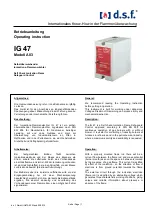
1. INSTALLATION
IOM manual active pulsation dampeners
9
1.4.2.
Explosion hazardous environments
–
ATEX
The standard DT series dampeners are not allowed to operate in environments where there is
danger of explosion. Static electricity may occur in the dampener under operation, which may
cause explosion and injury. Special conductive DTX dampeners are available for such
applications. Follow below instructions and local/national rules for safe use.
ATEX (directive 2014/34/EU) classification of Tapflo DTX dampeners.
ATEX
II 2 GD
IIB
c
T4
Equipment group:
II
–
all other explosive areas than mines;
Category group:
2
–
high level of protection (can be used in zone 1);
Atmosphere:
G
–
gas;
D
–
dust;
Explosion group:
IIB
–
such as ethylene;
Type of protection:
c
–
constructional safety;
Temperature class:
T4
–
in the event of a malfunction, the maximum temperature of a
surface that may be exposed to gas
T4
= 135 °C.
Earth connection of the dampener and other equipment
Connect a suitable earth wire to the stainless steel earth connection that is placed on the top
or on the side of the dampener block , depending on dampener size and execution. Connect
the other end of the earth wire to earth and also make sure that other equipment like
hoses/pipes/containers etc. are properly earthed/connected.
1.4.3.
Air pressure
The maximum air pressure for standard Tapflo dampeners is 8 bar. Higher air pressure than 8
bar can damage the dampener and may cause injury to personnel in vicinity of the dampener.
For higher pressure rate, up to 16 bar (depending on the size) see optional dampener execution
in chapter 4.2. DTF series.
Please make sure that supply air to the dampener must have the same flow and pressure as the
pump that dampener is installed with.
1.4.4.
Noise level
At tests, the noise level from a Tapflo dampener has not exceeded 70 dB(A). Under some
circumstances, for example if the dampener is operating under high air pressure at low
discharge head, the noise can be inconvenient or hazardous for personnel staying for long
periods in the vicinity of the dampener. This hazard can be prevented by:
➢
using suitable ear protection;
➢
lowering the air pressure and/or raising the discharge head.
Содержание DT Series
Страница 27: ...6 DATA IOM manual active pulsation dampeners 27...
Страница 35: ......










































